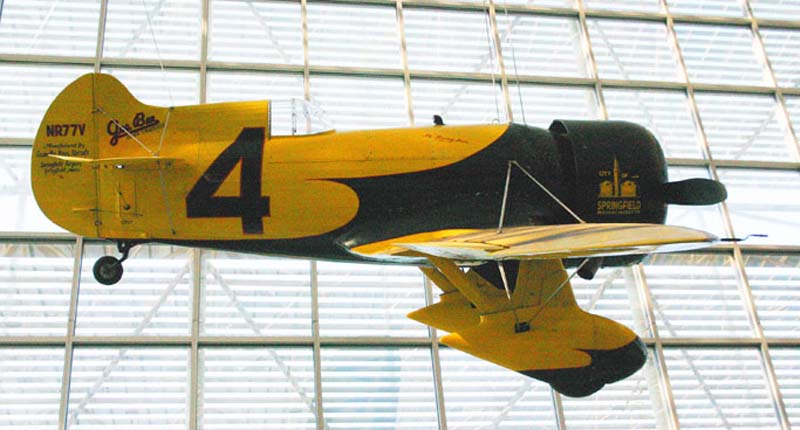|
Granville
Brothers Aircraft
was an aircraft manufacturer in
operation from 1929 until its
bankruptcy in 1934. The firm was
located at the Springfield Airport
in Springfield, Massachusetts. The
Granville Brothers, Zantford,
Thomas, Robert, Mark and Edward are
best known for the production of the
three Gee Bee Super Sportster air
racers, the Models Z, R1 and R2,
which are synonymous with the golden
age of air racing. |
|
|
AIRCRAFT |
|
| The
Granville Brothers built
only 24 aircraft. Only two
original aircraft are known
to exist. |
|
|
|
|
Model A biplane |
Nine built, 2
survive, one at the
New England Air
Museum. |
|
Model X Sportster |
Flown in the Cirrus
Derby. One built,
crashed September
1931, Roscoe Brinton
bailed out. |
|
Model B Sportster |
With a
Warner radial engine.
One built, rumored
to have been used in
the Spanish Civil
War, still flying in
late 1940s in Spain. |
|
Model C Sportster, |
Menasco inline engine
(one built, destroyed at
an air show crash in
Jersey City, New Jersey
October 25, 1931,
killing Harry E.R. Hall) |
|
Model D Sportster |
With in-line Menasco
Engine. One built,
crashed July 1936,
pilot Channing
Seabury killed
bailing out. |
|
Model E Sportsters |
With
Warner radial engine. Four built, all
destroyed.
- Crashed February 1934,
Z.D. Granville killed,
Spartanburg, South
Carolina.
- Crashed August 1932,
Russell Boardman
suffered a bad
concussion
- Crashed February 14,
1931 airshow at Candler
Field Atlanta. Johnny
Kytle killed
- Destroyed in crash. The
wing is at the EAA
AirVenture Museum
|
|
Model Y Senior
Sportster |
Two
built, both
destroyed. |
|
|
- Warner radial, prop came
apart and the aircraft
spun in.
- Lycoming test bed, later
fitted with a Wright
Whirlwind. Florence
Klingensmith killed in
1933 National Air Races
crash.
|
|
Model Z Super
Sportster |
Pratt & Whitney
"Wasp" powered, 1931
Thompson Trophy
winner (one built,
destroyed December
5, 1931, Lowell
Bayles killed.
Reproduction on
display at the
Museum of Flight,
Seattle, Washington.
|
|
Model R-1 Super
Sportster |
Pratt & Whitney
"Wasp" powered, 1932
Thompson Trophy and
Shell Speed Dash
winner, Jimmy
Doolittle pilot. One
built, destroyed
July 1, 1933,
Russell Boardman
killed. |
|
Model R-2 Super
Sportster |
Pratt & Whitney
"Wasp" powered. One
built, destroyed
late 1933, Jimmy
Haizlip injured. |
|
Model R-1/2 Super
Sportster |
Pratt & Whitney
"Wasp" powered,
built from remains
of the R1 and R2.
One built, destroyed
1935, Cecil Allen
killed. |
|
Gee Bee Model Q |
Aeronca powered
tractor canard built
to test
configuration (one
built, crashed 24
December 1931, Mark
Granville injured) |
|
Gee Bee Q.E.D |
Pratt & Whitney
"Wasp" powered. One
built, crashed June
7, 1939, Francisco
Sarabia killed,
aircraft rebuilt and
retired to a museum
in Ciudad Lerdo,
Durango, Mexico. |
|
Source:
Wikipedia |
|
|
|

